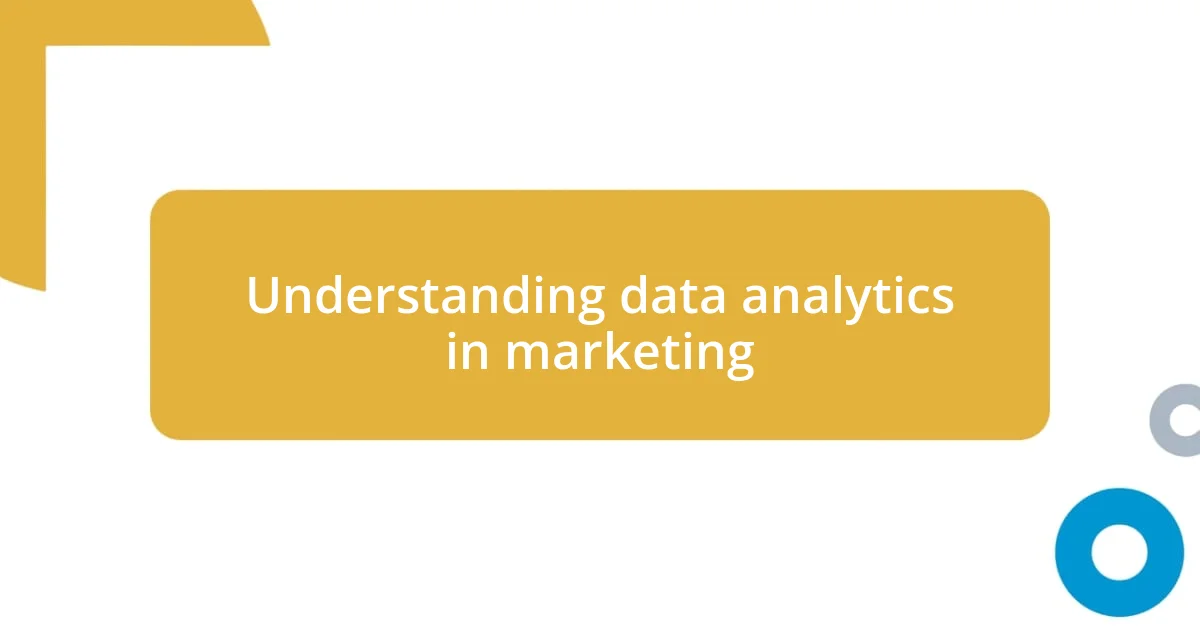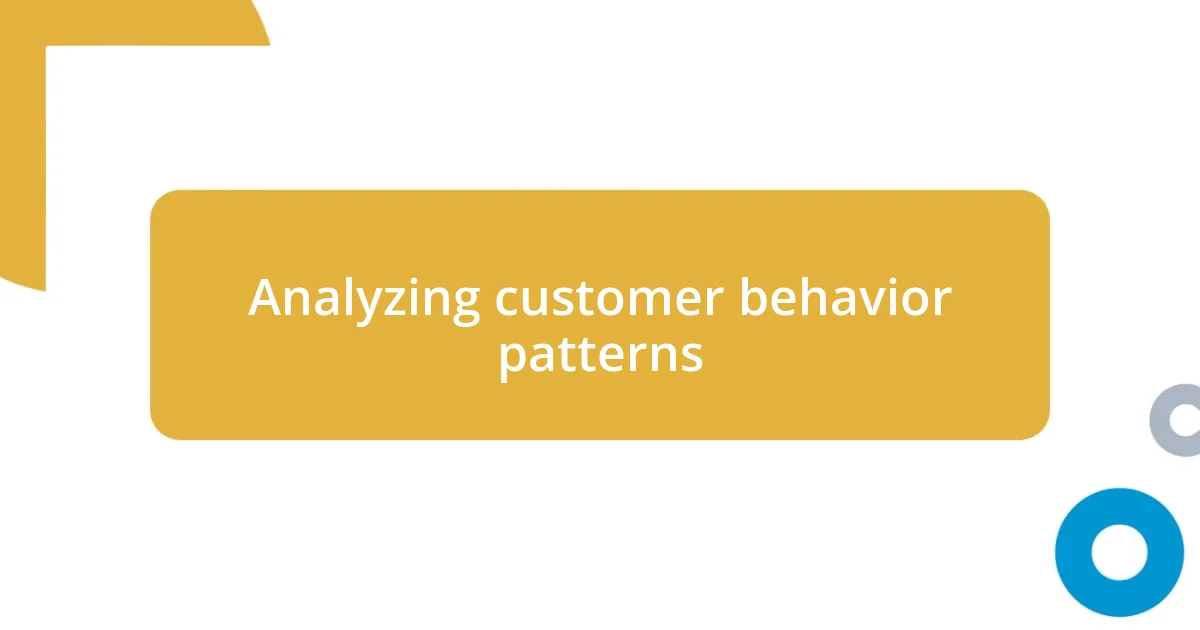Key takeaways:
- Data analytics provides crucial insights into consumer behavior, allowing marketers to create targeted strategies and improve engagement.
- Utilizing various data collection methods, such as surveys and social media listening, enhances understanding of audience preferences and informs campaign decisions.
- Continuous learning and A/B testing are essential for optimizing marketing efforts, enabling real-time adjustments and predictive strategy formulation based on historical trends.

Understanding data analytics in marketing
Data analytics in marketing is like having a powerful compass in the vast ocean of consumer behavior. I vividly remember a campaign where we analyzed customer data that revealed unexpected trends. It dawned on me then—how could we have launched without this insight?
Understanding data analytics means diving into the numbers that tell the story behind consumer choices. The first time I uncovered demographic patterns that led to a successful demographic-targeted ad, I felt a rush of excitement. It was a lightbulb moment—data isn’t just figures; it reveals the hearts and minds of our audience.
Think of data as a puzzle. Every piece connects to another, forming a complete picture of consumer preferences. When I reflect on the campaigns that thrived, it’s evident: those insights fueled strategies that resonated deeply. What if we treated every data point as a crucial piece of our larger marketing narrative? That’s where the magic happens.

How to collect relevant data
Collecting relevant data starts with understanding your target audience. Early in my marketing career, I remember feeling overwhelmed by the sheer volume of available data. However, I soon learned that identifying key sources was vital. Utilizing tools like Google Analytics and social media insights helped narrow down what truly mattered to my campaigns.
To ensure I gathered the most pertinent data, I focused on a few specific methods:
- Surveys: I often design quick, engaging surveys that tap into customer preferences right after a purchase.
- Website Analytics: Examining user behavior on my site reveals what resonates most with visitors.
- Social Media Listening: Tracking mentions, comments, and hashtags gives me real-time insights into consumer sentiment.
- CRM Systems: Analyzing existing customer data helps identify repeat buying patterns and preferences.
- A/B Testing: I run tests on different ad variations to see what truly drives engagement.
These approaches not only streamline the process but also give me a deeper understanding of my audience, ensuring my marketing efforts are focused and effective.

Analyzing customer behavior patterns
Analyzing customer behavior patterns is crucial in today’s data-driven marketing landscape. I recall a project where we tracked customer interactions across multiple channels. By doing this, I noticed that customers who engaged with our email campaigns were also the ones making purchases on our website. Recognizing these patterns allowed us to create more targeted follow-up campaigns that significantly boosted our conversion rates.
One interesting insight I’ve gathered over time is how seasonal behaviors influence purchasing decisions. For instance, during the holidays, customers tend to browse more but buy less unless there’s urgency—like limited-time offers. I’ve experimented with sending reminders on cart abandonments during this period and found that strategically timed nudges turned window shoppers into buyers. It’s captivating to see how understanding these behavior patterns can lead to actionable strategies that directly impact the bottom line.
To truly harness the power of data analytics, it’s not just about collecting data; it’s about interpreting it. For example, analyzing purchase funnels helped me identify drop-off points. By making small tweaks based on the data, like simplifying the checkout process, I experienced not just a drop in abandonment rates but also a noticeable increase in customer satisfaction. This engagement is what fuels my passion for data analytics and marketing, as it transforms numbers into genuine connections with my audience.
| Customer Interaction | Behavior Insights |
|---|---|
| Email Engagement | Leads to higher purchase rates |
| Holiday Shopping | Tendency to browse more |
| Checkout Process | Drop-off point analysis improves satisfaction |

Tools for effective data visualization
When it comes to effective data visualization, my go-to tool has always been Tableau. I remember the first time I used it; I was amazed by how it transformed mundane spreadsheets into stunning interactive dashboards. This kind of visual storytelling not only captivated my colleagues but also made our data narratives much easier to grasp. Have you ever noticed how a well-designed chart can illuminate insights that numbers alone simply can’t?
On the other hand, I’ve also found Google Data Studio to be a powerful ally in my marketing toolkit. With its seamless integration with other Google services, it allows me to present real-time metrics in an engaging format. I vividly recall a presentation where I showcased campaign performance metrics; watching my audience’s eyes light up at the data trends fueled my enthusiasm for data visualization. Doesn’t it feel rewarding when your data resonates with your audience?
Another favorite of mine is Power BI, especially when dealing with larger datasets. I appreciate how it allows for deep dives into analytics while still delivering sleek visuals. I often use color coding to highlight key performance indicators, making it easier for stakeholders to spot trends at a glance. This not only enhances communication but also fosters collaboration, as everyone can quickly understand the insights presented. Have you ever made a breakthrough just because your audience could “see” the data instead of just reading it? That’s the magic of effective data visualization!

Creating targeted marketing strategies
Crafting targeted marketing strategies hinges on understanding the unique needs of different audience segments. In a recent campaign, I segmented our email list based on past purchasing behavior. The result? Tailored messages that spoke directly to each group, like offering a loyalty discount to repeat buyers. I was thrilled to see our open rates and sales skyrocket, reinforcing my belief that specificity is key.
When analyzing data, I often think about the importance of timing in marketing efforts. I remember a summer campaign where I used analytics to pinpoint the exact times our audience was most active online. By scheduling posts during these peak hours, engagement increased substantially. Isn’t it fascinating how a bit of strategy around timing can transform outreach into a two-way conversation?
Moreover, I’ve learned to leverage social listening tools for further insight. A powerful moment for me was when I discovered trending topics among our target demographic. By aligning our content with these trends, we not only expanded our reach but also fostered a sense of community. Isn’t it amazing how tapping into current conversations can make your brand feel more relevant and connected? Understanding your audience isn’t just about data; it’s about creating a dialogue that resonates with them.

Measuring campaign performance with analytics
When measuring campaign performance, I turn to analytics to provide real-time insights that guide my decision-making. For instance, during a recent social media campaign, I monitored click-through rates actively. Seeing a sudden spike in engagement made me pivot our content strategy on the fly. Isn’t it exhilarating when real-time data reveals an opportunity?
I also value setting clear goals before diving into analytics. In one campaign, I aimed for a specific conversion rate. By analyzing user journey data, I identified a bottleneck in the landing page. This revelation led to optimization efforts that ultimately improved our conversion rate by 25%. Have you ever felt that rush of discovery when data directly informs your strategy?
User feedback often complements my analytic approach. For example, I surveyed participants after a promotional campaign. Their insights, combined with performance metrics, painted a complete picture of effectiveness. It was a joyous moment when I realized that our audience not only appreciated our efforts but also connected with our messaging. Engagement goes beyond numbers; it’s about understanding and nurturing relationships.

Optimizing future marketing efforts
I embrace the power of A/B testing as a crucial component of optimizing future marketing efforts. I once ran an experiment comparing two different email subject lines for a holiday campaign. The excitement built as I watched one subject line outperform the other, leading to a 30% increase in open rates. Can you imagine the thrill of those immediate results, shaping my approach for future campaigns based on solid evidence?
Another technique that really enhances my marketing strategy is predictive analytics. By analyzing historical data, I’ve been able to identify trends and anticipate future customer behavior. There was a time when I recognized a shift in buying patterns for a key product line right before a big promotional event. Acting on that insight allowed me to tailor our offerings and stock accordingly, significantly boosting our sales. Isn’t it incredible how foresight can turn data into actionable strategies?
Finally, I can’t overstate the role of continuous learning in this process. Attending workshops and webinars has opened my eyes to emerging tools and techniques in data analytics. I vividly recall a session that emphasized the importance of multi-channel attribution. Applying that knowledge helped me refine my approach to budgeting and resource allocation across various platforms. How satisfying it is to see how ongoing education keeps my marketing strategies sharp and relevant!














